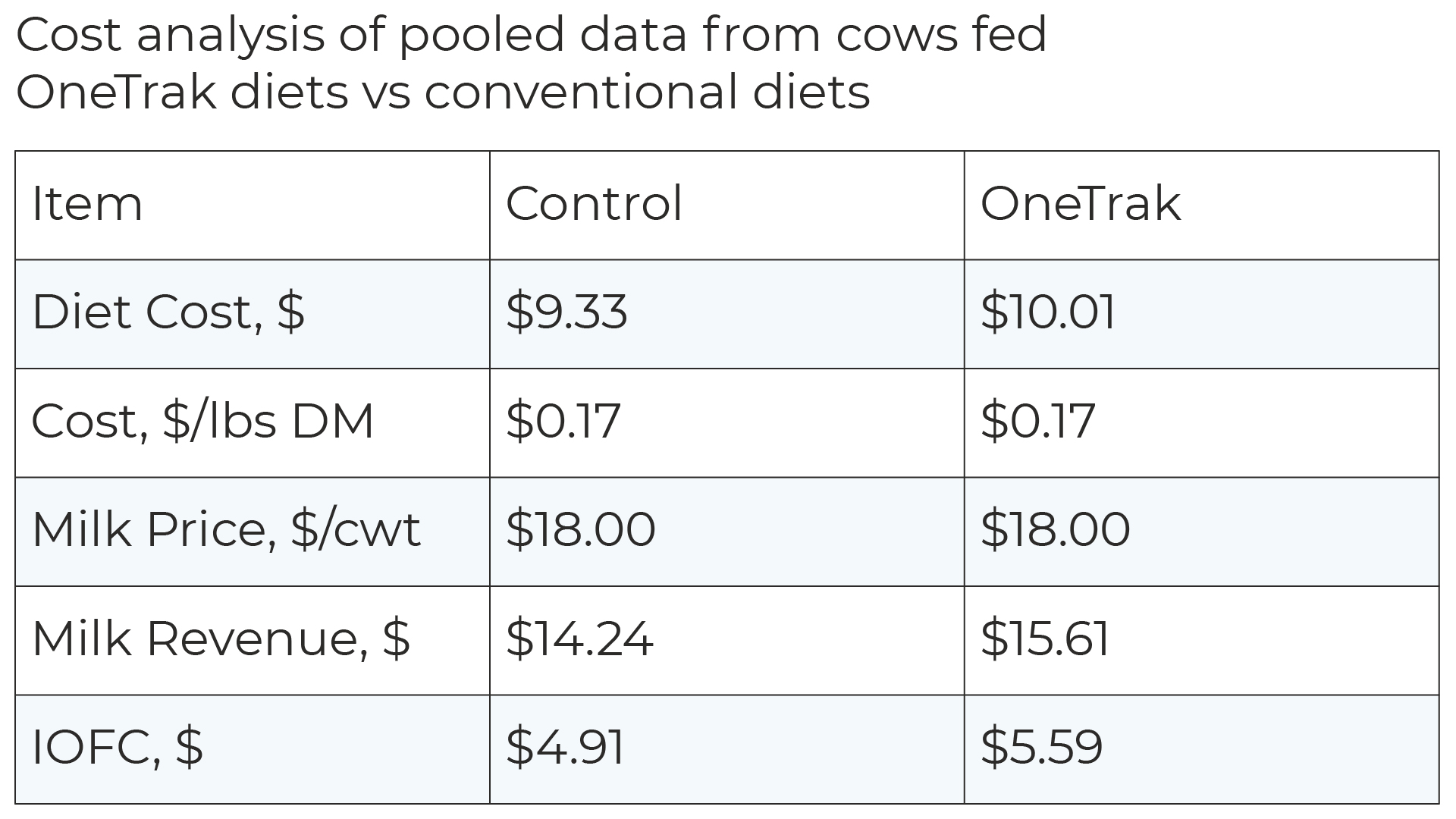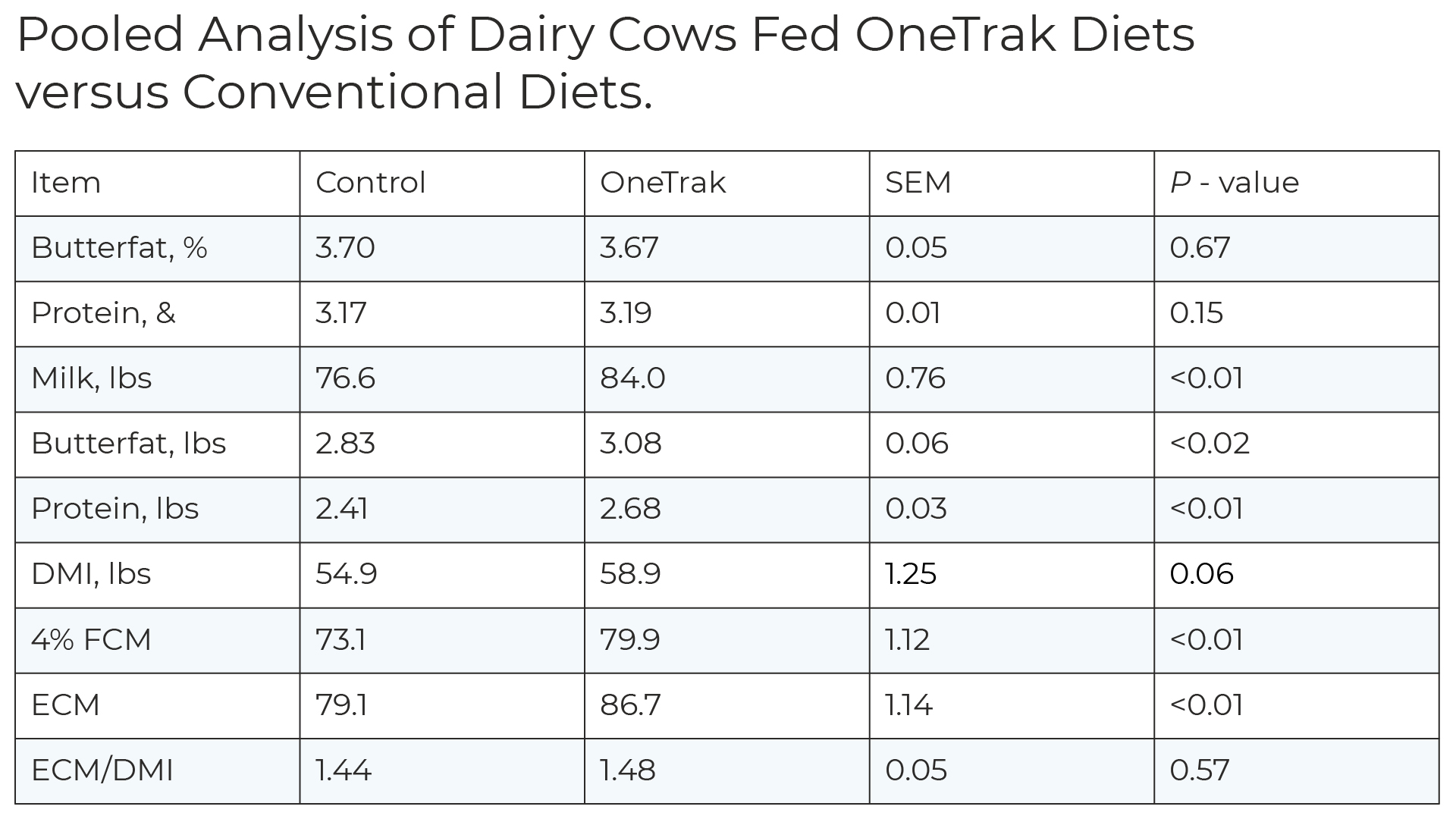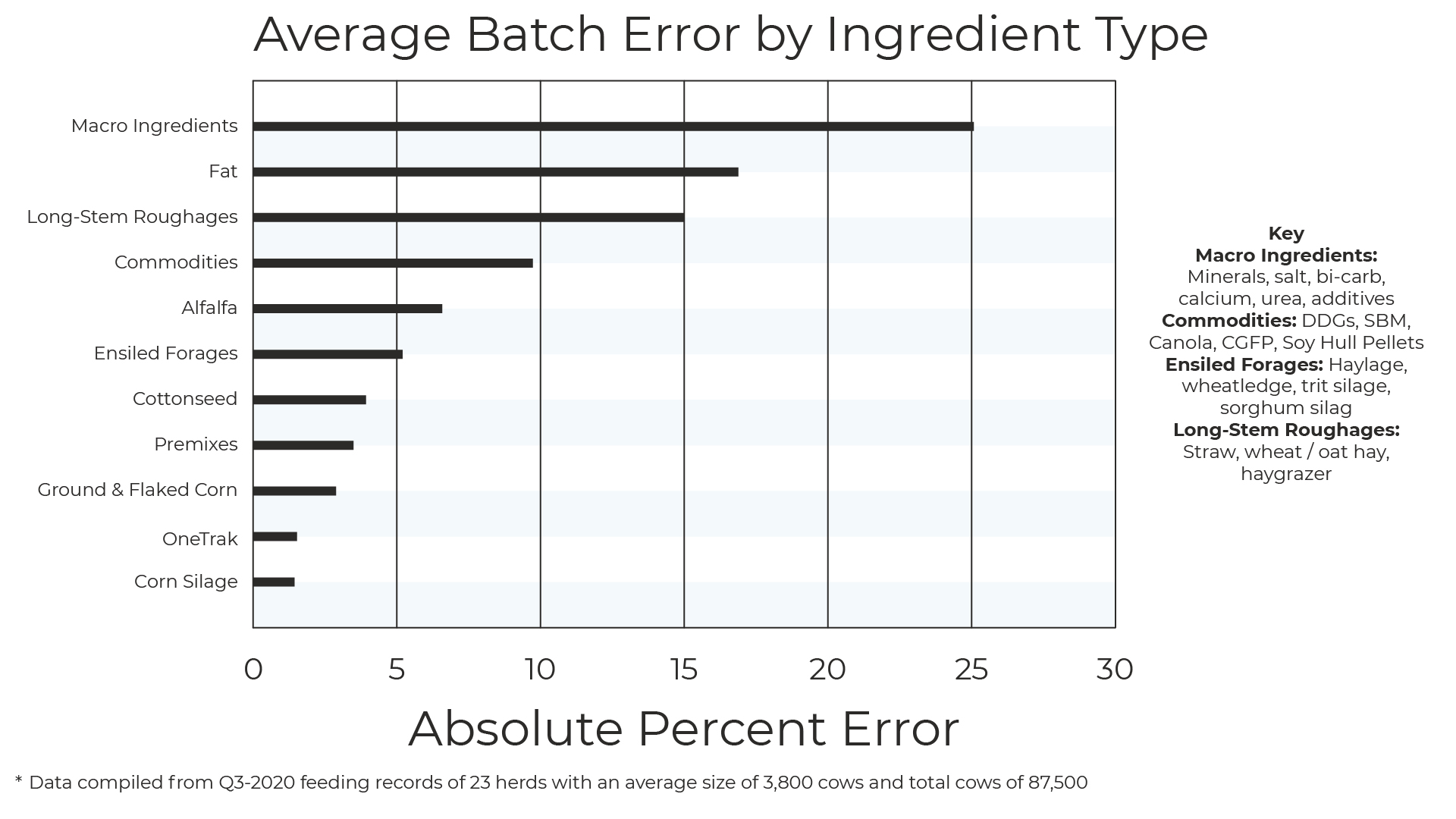OneTrak Claims.
A macro-ingredient for dairies that is Right Made Simple. Feeding practices are simplified while improving the health and performance of herds. Fed at 40% of the ration, it improves rumen health and results in greater energy intake and utilization of the entire diet.
OneTrak improves income over feed cost (IOFC)
In a pooled analysis of six research trials, IOFC was improved by over $0.60/hd. While this number changes depending on market dynamics, OneTrak consistently delivers improved economic returns to dairy operations.
Improved IOCF by over $0.60/hd
OneTrak improves milk production and components, leading to greater energy-corrected milk
In a pooled analysis of six research trials, where OneTrak was fed at 35–40% of the diet, milk production increased (7.4 lbs), component yield (both milk fat (0.25 lbs) and milk protein (0.27 lbs)) was improved, and fat and energy-corrected milk were increased (6.8 and 7.6 lbs, respectively).
Milk production increased by 7.4 lbs
Milk fat increased 0.25 lbs and protein by 0.27 lbs
OneTrak changes the rumen microbiome, resulting in improved nutrient utilization
OneTrak establishes a different microbial population vs. a conventional ration. This sets up the rumen to utilize the entire ration.
Improved energy utilization
- Feeding a branded, modified wet corn gluten feed to lactating dairy cows: a meta-regression approach
- Effects of ruminal ammonia and butyrate concentrations on reticuloruminal epithelial blood flow and volatile fatty acid absorption kinetics under washed reticulorumen conditions in lactating dairy cows
OneTrak promotes healthy rumen epithelial tissue, which helps maintain a healthy rumen pH
Feeding OneTrak in dairy diets provides more butyrate as a substrate in the rumen. This aids in keeping the rumen healthy. Butyrate helps the rumen epithelium to form, regenerate, and repair healthy tissue, which in turn can lead to better absorption by the animal and a more healthy rumen pH. Butyrate is important for rumen epithelial development and function and aids in increased blood flow to the rumen and VFA absorption (Storm et al., 2011). A meta-regression analysis showed that butyrate concentrations increased in OneTrak diets. This may improve VFA absorption from the rumen, which may aid in maintaining a healthy rumen pH (Krogstad et al., 2021).
Less variable rumen pH
Higher overall rumen pH
- Feeding a branded, modified wet corn gluten feed to lactating dairy cows: a meta-regression approach
- Effects of ruminal ammonia and butyrate concentrations on reticuloruminal epithelial blood flow and volatile fatty acid absorption kinetics under washed reticulorumen conditions in lactating dairy cows
Optimal inclusion rate of OneTrak in the diets is between 35–40% of the diet dry matter, replacing a combination of grain, concentrate protein, and forages
A series of trials was completed looking at optimal replacement of concentrates and forages. While studies showed that as much as 70% of the diet could be replaced, optimal replacement based on performance is between 35–40% of the diet dry matter.
35–40% of the diet dry matter
- Maximal replacement of forage and concentrate with a new wet corn milling product for lactating dairy cows
- Effects of feeding increasing levels of wet corn gluten feed on production and ruminal fermentation in lactating dairy cows
- Milk production of dairy cows fed wet corn gluten feed during the dry period and lactation
- Effects of wet corn gluten feed on ruminal pH and productivity of lactating dairy cattle fed diets with sufficient physically effective fiber
- Response of lactating Holstein cows to increasing amounts of wet corn gluten feed
At recommended inclusion levels, OneTrak increases DMI (dry matter intake) by as much as four lbs, without sacrificing efficiency of energy-corrected milk production
In an analysis of six studies, where OneTrak was fed between 35-40% of the diet, DMI was increased by four lbs (P=0.06), while ECM/DMI was not different between the treatments.
Increases DMI by as much as 4 lbs
Reduced batching time
Eliminating ingredients and a premix saves dairies an average of two hours of batching time every day.
Save an average of 2 hours of batching time per day
Feeding OneTrak improves efficiency and simplifies the dairy operation by eliminating the need for a premix
Feeding OneTrak at 40% of the diet eliminates the need to make an on-farm premix. This translates into about another hour/day of time savings attributed to the simplicity of OneTrak.
Eliminates need to make an on-farm premix
Feeding OneTrak simplifies the operation by eliminating 4–5 ingredients (on average) that an operation has to source and handle
When feeding OneTrak, dairies typically eliminate 4–5 ingredients on-farm, with some commercial herds replacing as many as nine. This translates into an average time savings per batch of over 4.5 minutes, and adds up to about an hour of time savings in batching the TMR daily.
Simplifies sourcing and batching
Research and Documentation
-
Peer
Effects of ruminal ammonia and butyrate concentrations on reticuloruminal epithelial blood flow and volatile fatty acid absorption kinetics under washed reticulorumen conditions in lactating dairy cows
2011 Aarhus University, Denmark; Virginia Polytechnic Institute and State University, Blacksburg
-
Internal
Pooled analysis of OneTrak research data
-
Peer
Effects of fat supplementation to diets high in non-forage fiber on production responses of mid-lactation dairy cows
2018 Kansas State University
-
Peer
Effects of feeding diets composed of corn silage and a corn-milling product with and without supplemental lysine and methionine to dairy cows
2019 Ohio State University
-
Peer
Use of a corn-milling product in diets for dairy cows to alleviate milk fat depression
2012 Ohio State University
-
Peer
Effects of wet corn gluten feed on ruminal pH and productivity of lactating dairy cattle fed diets with sufficient physically effective fiber
2012
-
Peer
Chewing, rumen pool characteristics, and lactation performance of dairy cows fed two concentrations of a corn wet-milling co-product with different forage sources
2014
-
Peer
Effects of varying rates of tallgrass prairie hay and wet corn gluten feed on productivity of lactating dairy cows
2012 Kansas State University
-
Peer
Effects of feeding increasing levels of wet corn gluten feed on production and ruminal fermentation in lactating dairy cows
2010 Kansas State University
-
Peer
Short communication: supplementing lysine and methionine in a lactation diet containing a high concentration of wet corn gluten feed did not alter milk-protein yield
2013 Kansas State University
-
Peer
Effects of alfalfa hay inclusion rate on productivity of lactating dairy cattle fed wet corn gluten feed-based diets
2009 Kansas State University
-
Peer
Feeding a branded, modified wet corn gluten feed to lactating dairy cows: a meta-regression approach
2021 Michigan State University
-
Peer
Estimation of the proportion of feed protein digested in the small intestine of cattle consuming wet corn gluten feed
2007 University of Nebraska-Lincoln
-
Peer
Milk production of dairy cows fed wet corn gluten feed during the dry period and lactation
2006 University of Nebraska-Lincoln
-
Peer
Nitrogen utilization, nutrient digestibility, and excretion of purine derivatives in dairy cattle consuming rations containing corn-milling co-products
2010 University of Nebraska-Lincoln
-
Internal
Response of lactating Holstein cows to increasing amounts of wet corn gluten feed
2006 Kansas State University
-
Peer
Maximal replacement of forage and concentrate with a new wet corn milling product for lactating dairy cows
2001 Kansas State University
-
Internal
Evaluation of alternative sources of rumen undegraded protein with wet corn-milling by-products for dairy cattle
2002 University of Nebraska-Lincoln
-
Internal
Effects of a dairy-protein product on dry matter intake and yield of milk and milk components of Holstein cows
2012 University of Nebraska-Lincoln
-
Peer
Interactions between forage and wet corn gluten feed as sources of fiber in diets for lactating dairy cows
2000 University of Nebraska-Lincoln



